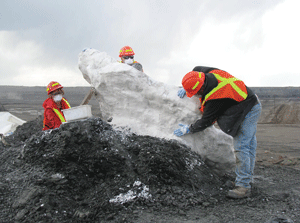
The Royal Tyrrell Museum is swimming in aquatic prehistoric beasts these days. Their relationship with Syncrude has resulted in the collection of two specimens from a Syncrude mine near Fort McMurray.
On May 11, shovel operator Jason Young, had the surprise of the lifetime when he noticed his shovel had uncovered some dark rocks amidst the light grey rocks typical of the region.
“I was digging into the mine face and came across something of a different colour. I got down and had a closer looks and realized what it was,” said Young. “I remember being at the Tyrrell Museum when I was younger and knew what a fossil looks like just from seeing them there. When I saw this one in the area I was, it was pretty amazing.”
Young had taken the fossil identification course with Syncrude as well.
After he saw the fossils, the liaison for the Tyrrell was called in and the museum was contacted.
“If they notice anything, they stop digging right away and then our liaison with the Royal Tyrrell Museum comes out and takes a look and contacts the museum. We work with the Tyrrell to make sure we preserve the fossil, because it’s a resource shared by all Albertans,” said Cheryl Robb, media advisor for Syncrude. “It’s exciting for all of us at Syncrude. I think all of us are kids at heart.”
Another specimen had been found earlier on May 7 and Tyrrell staff were going to be heading up anyway to collect a specimen uncovered in November, 2011. All three were brought to the Tyrrell.
The two newer fossils are from the early Cretaceous period, roughly 112 to 114 million years ago. The fossils have been identified as being Elasmosaurs, predatory marine reptiles characterized by long necks, small heads, and barrel-shaped bodies.
The May 11 specimen is estimated to be 70 to 80 percent complete and has a partial skull preserved. However, preparation of the specimens may take some time due to the quality of the bone and the number of specimens the museum needs to prepare.
“The bone is like compressed talcum powder and the matrix is really hard. The preparation is going to be slow,” said Dr. Don Henderson, curator of dinosaurs at the Tyrrell Museum. “We’ve had this flood of specimens from around the province. We’re just going to have to wait for a bit.”
Because the fossils are still in the rock, it is unknown at the moment if they represent new species of Elasmosaur or are specimens of Wapuskanectes, an Elasmosaur found roughly ten years ago from the same area.
“We can’t tell. We’ve kept them in the rock to help keep them together.” “For the one we found in November, the centra [vertebrae] on the neck are elongate. The skull we’ve got is elongate.
There have been a number of specimens found at the Syncrude North Mine over the years. It is unclear at this time what caused the concentration of fossils in the area.
“We need the stratigraphic [the layer of rock] position to test any hypotheses,” said Henderson. “It may be an area where ancient wind and water currents concentrated carcasses. Unless you know they are all from the same time, the palaeogeography will shift over time. We just have to wait a few more years and get accurate vertical and horizontal positions and plot them on maps. Then we’ll get a better picture.”
Henderson estimated preparation would wait until at least October of this year. The three specimens are being housed in unprepared storage for now.